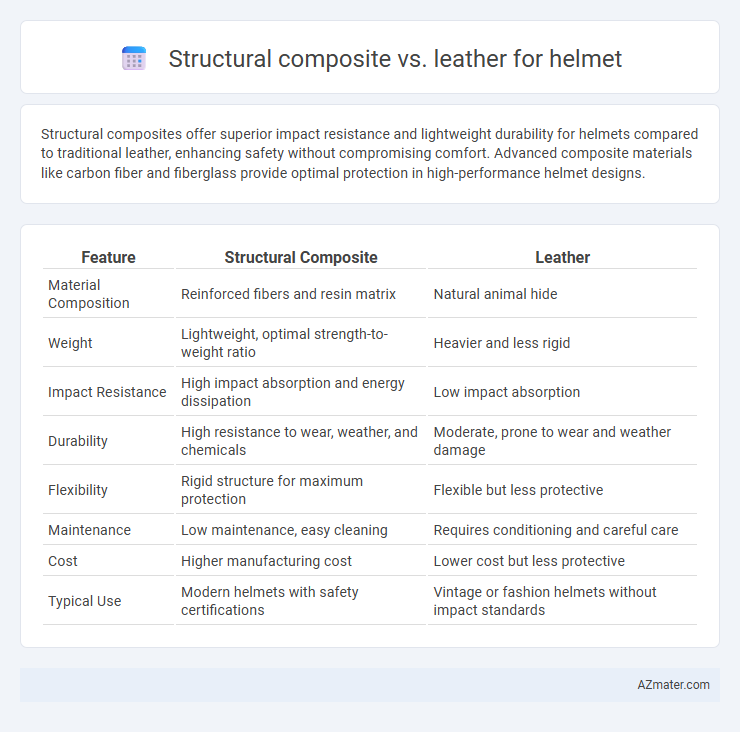Structural composites offer superior impact resistance and lightweight durability for helmets compared to traditional leather, enhancing safety without compromising comfort. Advanced composite materials like carbon fiber and fiberglass provide optimal protection in high-performance helmet designs.
Table of Comparison
| Feature | Structural Composite | Leather |
|---|---|---|
| Material Composition | Reinforced fibers and resin matrix | Natural animal hide |
| Weight | Lightweight, optimal strength-to-weight ratio | Heavier and less rigid |
| Impact Resistance | High impact absorption and energy dissipation | Low impact absorption |
| Durability | High resistance to wear, weather, and chemicals | Moderate, prone to wear and weather damage |
| Flexibility | Rigid structure for maximum protection | Flexible but less protective |
| Maintenance | Low maintenance, easy cleaning | Requires conditioning and careful care |
| Cost | Higher manufacturing cost | Lower cost but less protective |
| Typical Use | Modern helmets with safety certifications | Vintage or fashion helmets without impact standards |
Introduction: Comparing Structural Composites and Leather Helmets
Structural composite helmets, crafted from materials like fiberglass, carbon fiber, and Kevlar, offer superior impact resistance and lightweight durability compared to traditional leather helmets. Leather helmets provide basic abrasion protection and flexibility but lack the advanced safety features and structural integrity found in composite designs. The evolution from leather to structural composites marks a significant advancement in helmet technology, enhancing rider protection and comfort.
Historical Evolution of Helmet Materials
Structural composite helmets emerged in the late 20th century, combining carbon fiber, fiberglass, and Kevlar to offer enhanced impact resistance and lightweight durability compared to traditional materials. Leather helmets, widely used during World War I and early aviation, provided basic protection but lacked the advanced shock absorption and structural integrity found in modern composites. The transition from leather to structural composites reflects advancements in material science aimed at improving safety standards and performance in protective headgear.
Material Composition: Leather vs Structural Composite
Structural composite helmets are primarily made from advanced materials such as fiberglass, carbon fiber, Kevlar, and resin, offering high strength-to-weight ratios and excellent impact resistance. In contrast, leather helmets utilize thick, tanned animal hide, providing flexibility, abrasion resistance, and comfort but significantly less structural protection against high-impact forces. The composite materials enable helmets to meet rigorous safety standards by effectively dissipating energy during impacts, whereas leather serves more for aesthetics and basic comfort without substantial protective capability.
Weight and Comfort Analysis
Structural composite helmets typically offer superior lightweight performance compared to leather helmets, enhancing wearer comfort during extended use. The advanced composite materials provide better impact absorption while maintaining a reduced weight, which minimizes neck strain and fatigue. Leather helmets, though durable, are generally heavier and less breathable, leading to reduced comfort and increased heat retention over long periods.
Protective Performance: Impact Resistance
Structural composite helmets utilize advanced materials such as fiberglass, carbon fiber, and Kevlar, providing superior impact resistance by effectively dispersing energy across the shell. Leather helmets, while offering some abrasion protection, lack the structural integrity and energy absorption capabilities necessary to mitigate high-impact forces. Studies show composite helmets outperform leather in reducing head injury risk during collisions, making them the preferred choice for enhanced protective performance.
Durability and Longevity
Structural composite helmets typically offer superior durability due to their multi-layered construction using fiberglass, carbon fiber, or Kevlar, which provides enhanced impact resistance and long-lasting performance. Leather helmets, while offering comfort and a classic aesthetic, generally lack the advanced protective properties and wear resistance found in structural composite materials. Over time, structural composites maintain their integrity better against environmental factors such as UV exposure and moisture, resulting in longer helmet lifespan and sustained safety standards.
Breathability and Moisture Management
Structural composite helmets offer enhanced breathability due to their lightweight fiber layers, which promote better airflow and reduce heat buildup during extended use. Leather helmets, while durable, typically lack ventilation features, resulting in less effective moisture management and increased sweating. The advanced materials in structural composites help wick away moisture and maintain comfort, making them superior for breathability and moisture control.
Design Flexibility and Customization
Structural composite helmets offer superior design flexibility and customization due to their ability to incorporate advanced materials like carbon fiber and Kevlar, allowing for intricate shapes and lightweight construction. Leather helmets, while classic in appearance, provide limited customization options and are often heavier with less aerodynamic designs. The composite materials facilitate enhanced ventilation systems, impact resistance, and a broader range of color and finish choices, making them ideal for personalized helmet designs.
Cost Comparison and Accessibility
Structural composite helmets generally offer a higher price point compared to leather helmets due to advanced materials like fiberglass, carbon fiber, and Kevlar, which provide superior protection and durability. Leather helmets, often more affordable, are widely accessible and favored for their vintage aesthetic and comfort but lack the advanced impact resistance found in composite models. Cost differences reflect the manufacturing complexity and safety standards, with structural composites being preferred for professional or high-performance use despite higher investment.
Conclusion: Choosing the Right Helmet Material
Structural composite helmets offer superior impact resistance and lightweight durability, making them ideal for high-performance riding and extended wear. Leather helmets provide enhanced comfort and classic aesthetics but lack the advanced protective qualities of modern composites. Choosing the right helmet material depends on prioritizing safety standards, weight, and intended usage, with structural composites generally recommended for optimal protection.

Infographic: Structural composite vs Leather for Helmet
 azmater.com
azmater.com